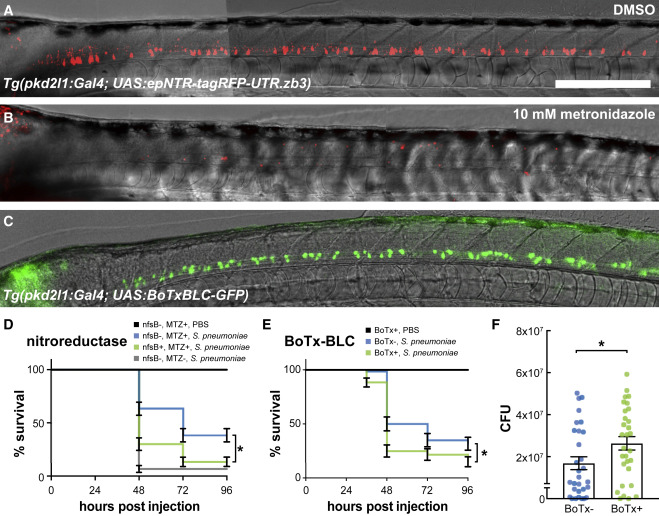Fig. 6
Figure 6. Secretory activity of CSF-cNs confers a survival benefit during pneumococcal meningitis (A) Tg(pkd2l1:GAL4; UAS:epNTR-tagRFPT-UTR.zb3) larva at 3 dpf following 24 h of incubation in 0.1% DMSO. Scale bars, 500 ?m. Figure S3 addresses how complete NTR expression is in the full complement of CSF-cNs. (B) Sibling larva incubated for the same time period in 10 mM metronidazole (MTZ). All tagRFP+ CSF-cNs are lost. (C) Expression of BoTxBLC-GFP in the Tg(pkd2l1:GAL4; UAS:BoTxBLC-GFP) larva at 3 dpf. (D) Survival curves of Tg(pkd2l1:GAL4; UAS:epNTR-tagRFPT-UTR.zb3)(nfsB) larvae and their siblings when exposed to metronidazole or DMSO from 1 to 2 dpf, washed with fish facility water, and subsequently infected with 4,000 CFU S. pneumoniae. Metronidazole alone slightly protects larvae against infection by S. pneumoniae (compare blue and gray lines, log-rank test, p < 0.0001). However, metronidazole-mediated ablation of CSF-cNs confers a large survival deficit (compare blue and green lines, log-rank test, p = 0.0002). The survival data represent the mean ± SEM of three individual experiments with n = 20 larvae per group (total n = 60 per group). (E) Survival curves of Tg(pkd2l1:GAL4; UAS:BoTxBLC-GFP) ("BoTx") larvae (green line) and non-transgenic sibling controls (blue line) injected with ?300 CFU S. pneumoniae D39 wild-type strain into the hindbrain ventricle at 2 dpf reveal that BoTx-expressing larvae exhibit higher mortality rates (log-rank test, p = 0.0065). The survival data represent the mean ± SEM of three individual experiments with n = 20 larvae per group (total n = 60 per group). Figure S7 shows that knocking out individual secreted factors identified by the transcriptome does not impair larval survival in the meningitis model. (F) Tg(pkd2l1:GAL4; UAS:BoTxBLC-GFP) (referred to as ?BoTx?) larvae (green line) exhibit higher bacterial loads at 24 h post injection as compared with non-transgenic sibling controls (unpaired t test, p = 0.0368). Each dot represents a single larva. Error bars = mean ± SEM of three individual experiments with n = 10 larvae per group (total n = 30 per group). See also Figures S3 and S7 and Table S1.
Image
Figure Caption
Acknowledgments
This image is the copyrighted work of the attributed author or publisher, and
ZFIN has permission only to display this image to its users.
Additional permissions should be obtained from the applicable author or publisher of the image.
Full text @ Curr. Biol.

